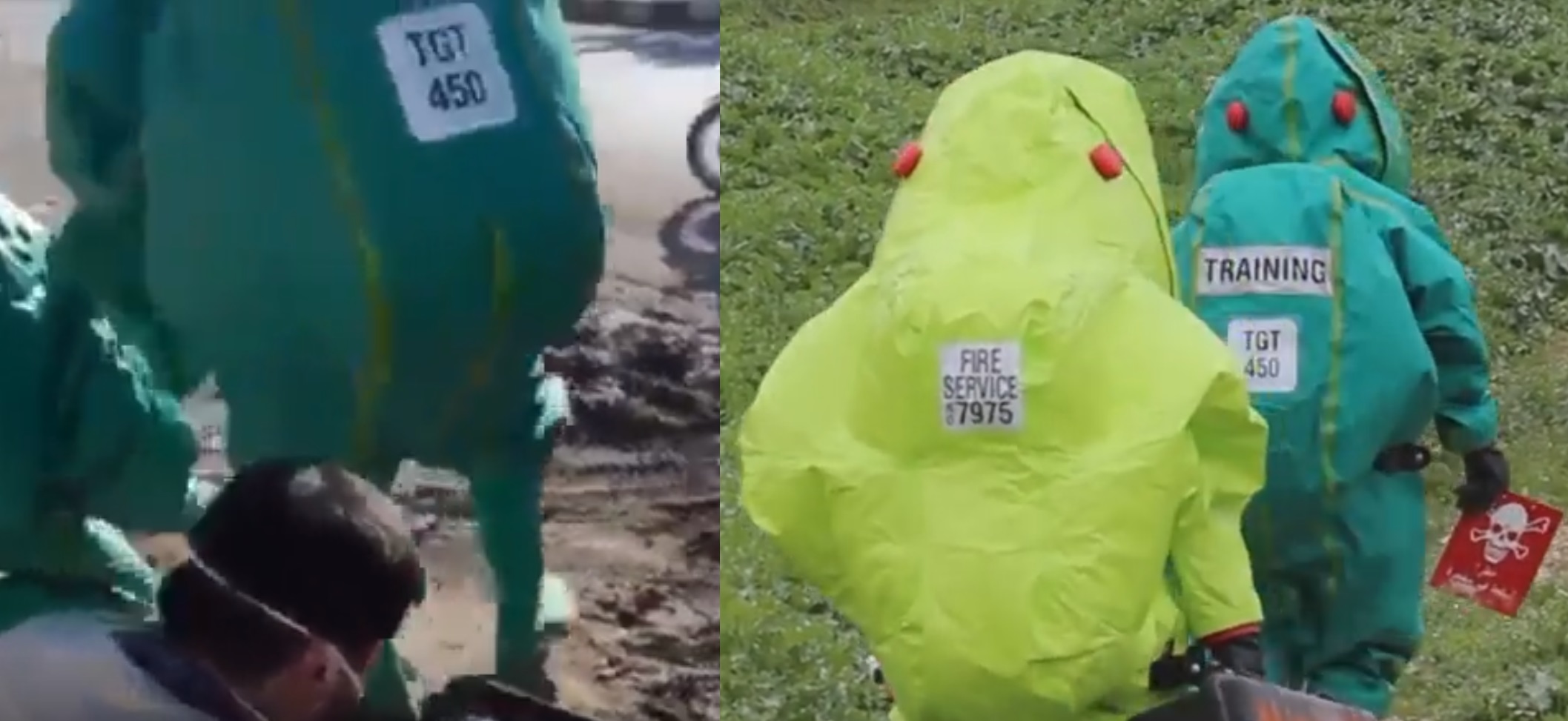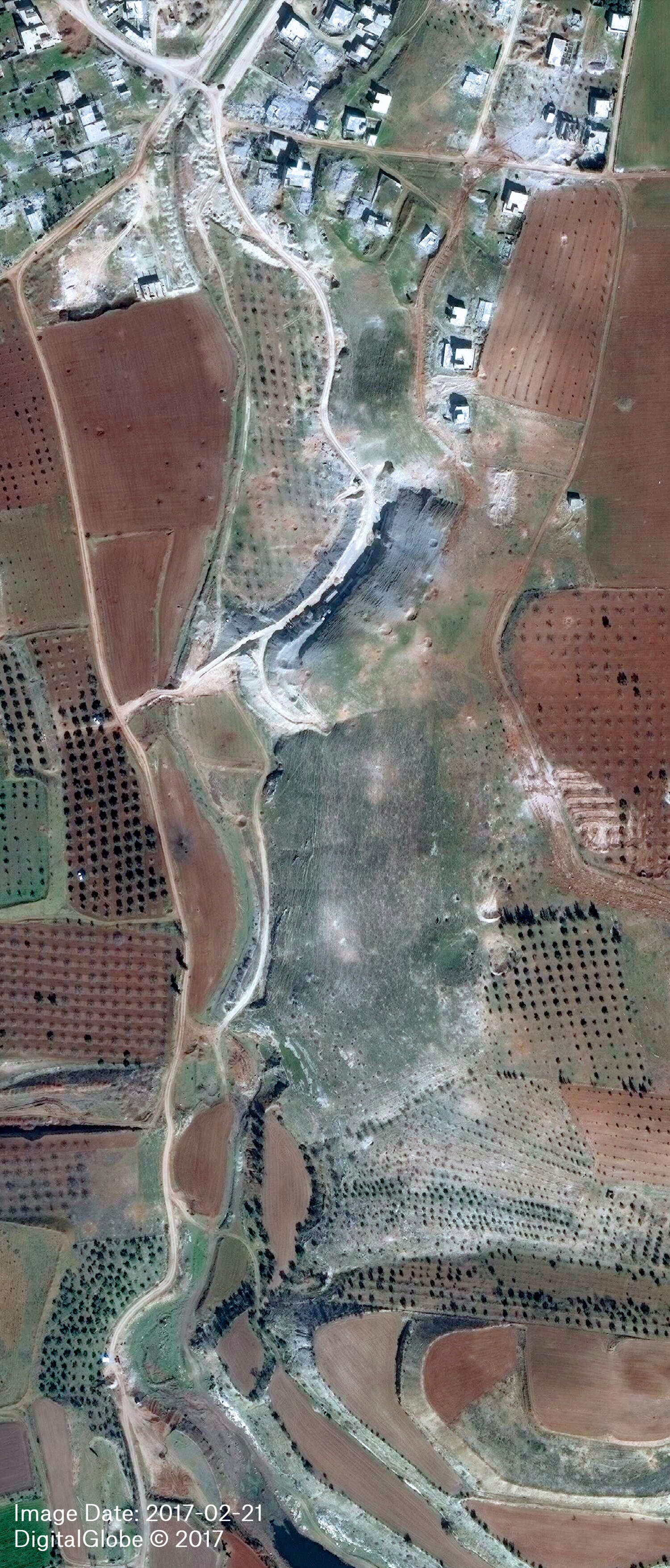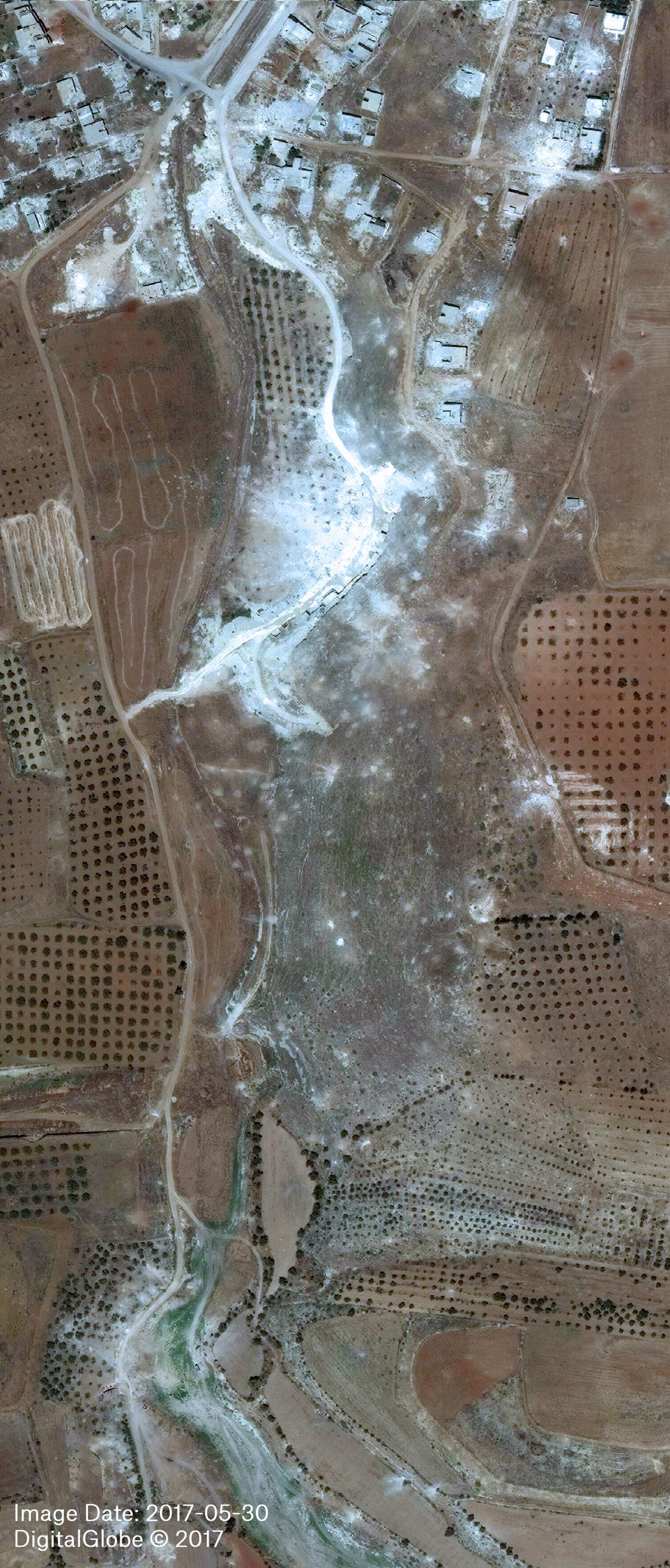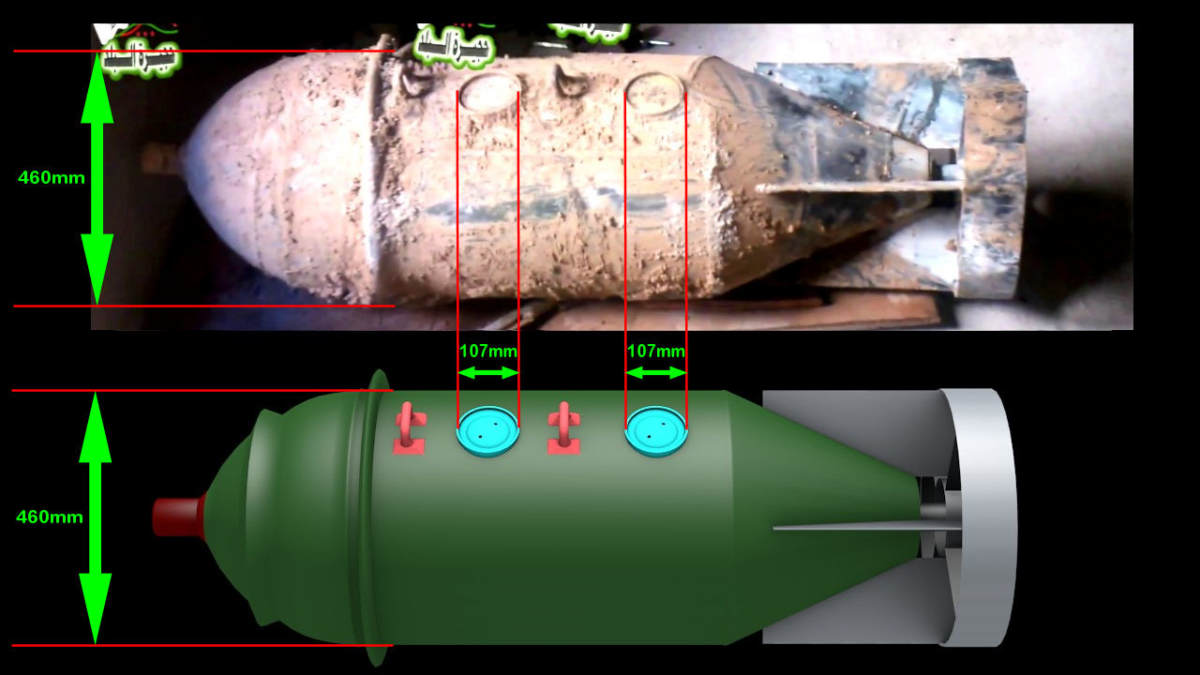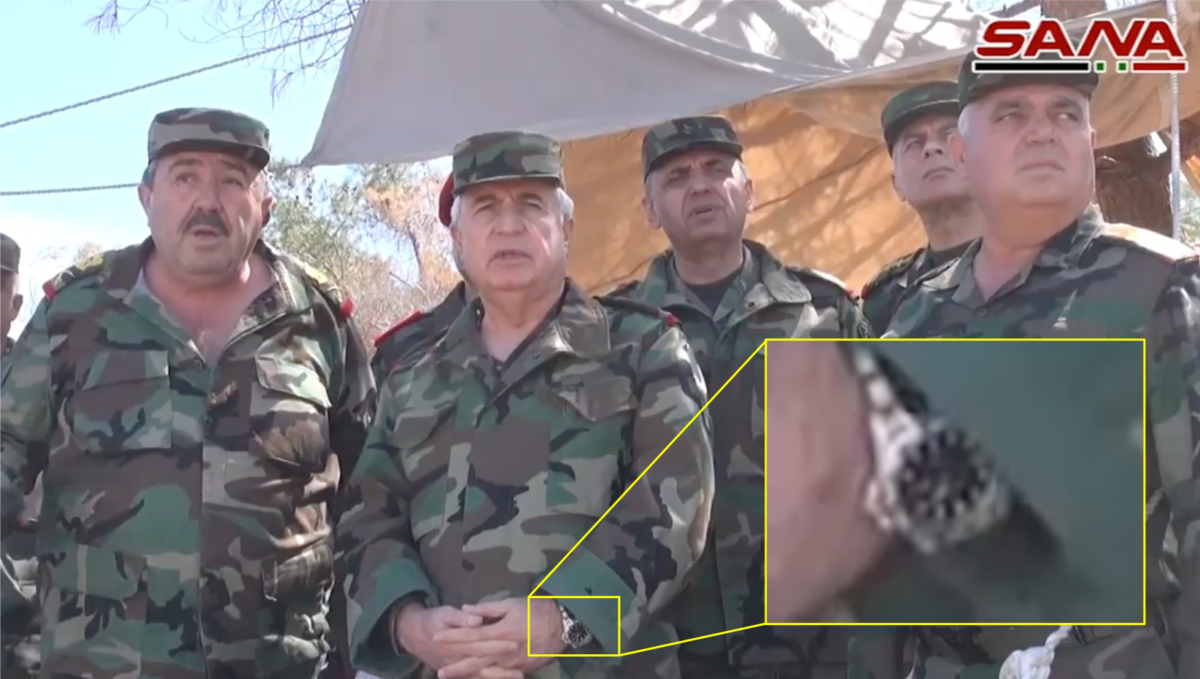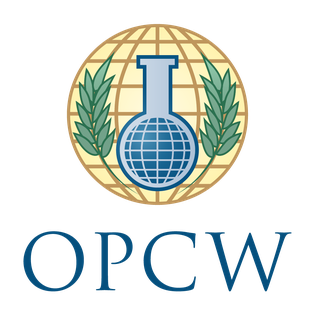Investigating the March 30, 2017 Sarin Attack in Al-Lataminah
As confirmed by open source evidence, OPCW and OHCHR findings, and witness statements, a Sarin attack took place on March 30, 2017 in Al-Lataminah, in addition to the widely-known April 4, 2017 Sarin attack in Khan Sheikhoun. Both of these attacks were executed by the Syrian Air Force. Furthermore, physical evidence filmed and photographed at the scene of the attack indicates the same type of bomb was used in both the Khan Sheikhoun Sarin attack and Al-Lataminah Sarin attack.
On October 4th, Ahmet Uzumcu, the head of the Organisation for the Prohibition of Chemical Weapons (OPCW), told the AFP that “Analysis of samples collected (by the OPCW)… relates to an incident that took place again in the northern part of Syria on the 30th of March this year,” with the results proving “the existence of sarin.” This analysis would confirm the presence of Sarin at the site of an alleged chemical attack five days before the April 4th Khan Sheikhoun chemical attack, where the OPCW also confirmed the presence of Sarin in their July 4, 2017 report.
The Sarin attack in question was in Al-Lataminah, and was featured in the UN’s Independent International Commission of Inquiry on the Syrian Arab Republic’s most recent report on the conflict:
“At around 6.30 a.m. on 30 March — five days after the chlorine attack on Al-Latamneh hospital by Syrian forces [Bellngcat’s report] — an unidentified warplane dropped two bombs in an agricultural field south of Al-Latamneh village. Interviewees recalled how the first bomb made almost no sound but released a “toxic material” absent any particular smell, while the second bomb caused a loud explosion. As a result of the former, at least 85 people suffered from respiratory difficulties, loss of consciousness, red eyes and impaired vision. Among the injured were 12 male farmers located 300 metres away from the impact point, 2 of them minors. Nine medical personnel who treated patients without protection also fell ill.”
“While the Commission is unable to identify the exact agent to which the victims of the 30 March incident were exposed, interviewees described certain symptoms, including a very low pulse in one case, and contracted pupils, suffocation, nausea and spasms in another, that indicate poisoning by a phosphor-organic chemical, such as a pesticide or a nerve agent. The absence of a characteristic chlorine odour, coupled with secondary intoxications among medical personnel treating victims, supports the conclusion that a toxic chemical other than chlorine was employed. Given that Syrian and Russian forces were conducting an aerial campaign in the area, the absence of indications that Russian forces have ever used chemical weapons in the Syrian Arab Republic, and the repeated use of chemical weapons by the Syrian air force, there are reasonable grounds to conclude that the Syrian air force used chemical weapons in Al-Latamneh on 30 March.”
While the Commission of Inquiry’s report did not specify the type of chemical agent used, the OPCW confirmation that Sarin was used makes this the second Sarin attack the Commission on Inquiry has blamed on the Syrian government.
Reports from the Ground
Following a March 22nd rebel offensive towards the city of Hama, Syrian government forces fought to regain territory lost in the initial rebel advance. Reuters reported on March 30 that aircraft pounded rebel-held areas north of Hama, including in Al-Lataminah, where Abdallah Darwish, head of the health authority for rebel-held parts of Hama province, told Reuters:
“The bombardment had a substance that caused intense irritation, heavy foaming from the mouth, and constricting pupils.”
A statement from the Hama Health Directorate describes how the attack took place at 6am on March 30, with multiple areas of the city targeted by bombardments, resulting in more than 78 victims. Some of these victims displayed symptoms of chemical exposure, including constricted pupils, a key symptom presented following exposure to Sarin. As a result of treatment, the statement claims 13 medical staff also displayed symptoms of chemical exposure.
Human Rights Watch reported details of the attack based on witness statements in its May report “Death by Chemicals”. According to the report:
“The Syrian American Medical Society said that its affiliated hospitals in the area treated 169 people for injuries due to chemical exposure, but that there were no fatalities. One of the witnesses said that the majority of those injured were members of armed groups, but that civilians in the area were injured as well.”
A local farmer, Anwar Rahmoun, told Human Rights Watch that the attack had occurred at 6am, with two bombs dropped near his location, around 100 meters away. According to Anwar Rahmoun “The first was not very loud, but the second shook the whole area.” Rahmoun also described the symptoms of exposure he felt following the attack:
“It felt like I was being drugged. I was running, my legs were touching the ground, but I could no longer feel them. Eventually I collapsed and lost consciousness. My brother-in-law said that they had to remove a lot of foam from all over my face when they found me. They took me to a hospital, thinking I was dead, but thankfully I regained consciousness seven hours later.”
These reports are mostly consistent with statements from doctors and victims in a video with English subtitles published by the Idlib Health Directorate, with one witness describing two “rockets” being fired at around 6:30am:
In a statement published by UOSSM USA, at least “70 civilians, including medical personnel, were injured from exposure to the chemical agent”, and detailed the symptoms:
“…nausea, agitation, foaming of the mouth, muscle spasms, and pinpoint pupils. Two patients went into cardiac arrest. No deaths have been reported.”
The statement from UOSSM USA also included an image of one of the victim’s pupils, showing it was constricted:
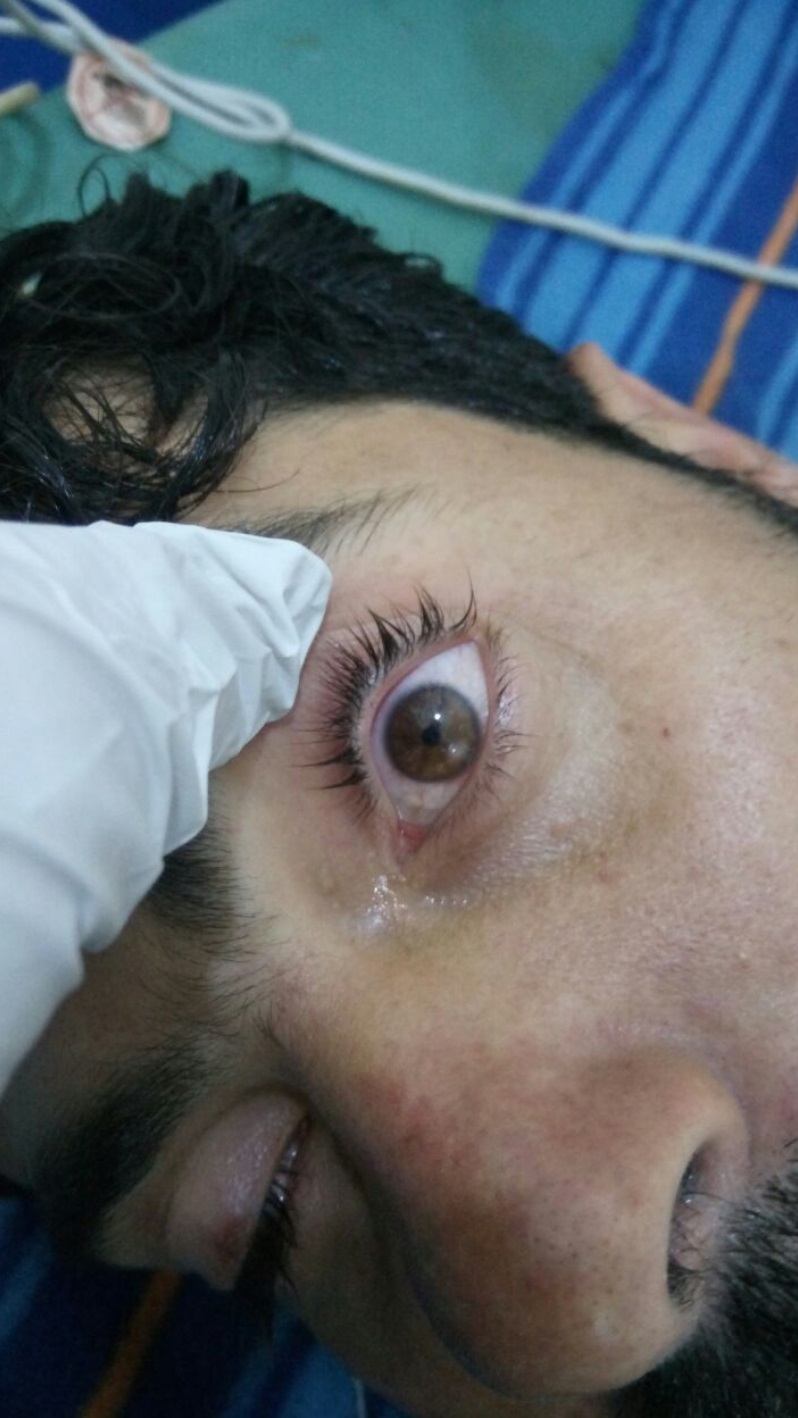
Bellingcat has also acquired videos of some of the victims of the attack shared by medical staff:
Other footage shows similar symptoms presented and described by witnesses as the above examples. There are, however, some differences in the figures given for the number of victims, ranging from upwards of 30 victims, with many of the victims being described as farmers. We were able to contact Anwar Rahmoun, the farmer who was interviewed in the Human Rights Watch report, who told us the following:
“The attack was from from 6 to 6:15. A MiG plane came and fired four rockets. We are civilians, we live at the outskirts of the village, mainly we are farmers. The fourth rocket was strong, we felt the poison.
We in the neighborhood are farmers and were going to the field. It was cumin season. I went inside one house as I entered inside the house I fainted there. I stayed unconscious for 12 hours.
I was taken to a hospital in Idlib there I stayed in the ICU for two days. When I woke up I felt there was fire inside my head the first ten minutes I could not move any part of my body. I felt total paralysis but after a while I started moving my body parts a bit. I stayed for 15 days suffering from breathing problems and when I opened my eyes I could not see. I stayed for ten days, I could not sleep because when I want to sleep I feel my whole body is dead. When I closed my eyes I felt like my whole body was dead for 10 days. They did not allow me to sleep. Whenever I wanted to sleep the doctors used to wake me up. I stayed in critical condition for ten days, but now, thank God, I’m fine.
(We went) to Turkey and to an international investigation commission. Someone took blood samples, they did an interview. More than 50 people were hit, among us children, also sheep died. 2000 square meters of grass were burnt. When they hit us I didn’t smell anything. I was helping people. Then I lost conscious. I was rescued after two hours. When they found me they thought I was dead. I had white foam coming out of my mouth and I was not awake.
We in the village we know each plane when it comes. We know the plane hit us with rockets but at first you only know these are rockets. You do not know if they were carrying poison. The plane that hit us was MIG plane with four rockets we heard it and we hide. But we have been witnessing this for six or seven years so we know from the sound what plane it was and what rocket if it was barrel bomb or rockets we know when an artillery shell is coming. All civilians know that. When we went to the hospital in Turkey Dr Mahmoud Abbas was with us and he documented everything.”
Anwar Rahmoun also provided a video of one of the victims who was treated in Turkey for 3 months when they were returning to Syria:
The man in the video states:
“They attacked us three months ago. Two days before Khan Sheikhoun attack. They attacked us with Sarin gas. This young guy has been in the emergency room for 3 months. We were 20 injured but he’s the one who got the most poison gas. The young guy is from Latamneh. The son of Karmo Nabhan. His hands and legs are dry. He can’t see with his eyes. We don’t know what to do with him.”
Dr. Mahmoud Abbas, whose presence in Turkey was described by Anwar Rahmoun, told us there were civilians and fighters among the victims, the symptoms showed the use of Sarin, and that he met with the OPCW for eight hours.
We also spoke to a White Helmets rescue worker, Abdel Manaf Saleh, who stated that he believed:
“They targeted workers in a agriculture field which was planted with cumin. The land which was targeted was far from headquarters (of rebels). The headquarter were more than 500 meters away.”
He went to to explain that the farmers were thinning the cumin fields to encourage growth among stronger plants. Abdel Manaf Saleh also stated that victims were taken to Turkey, where tests showed they had been exposed to Sarin.
The Attack Site
Collection of samples by members of Syrian Civil Defence featured in videos uploaded to YouTube by the SMART News Agency, Halab Today TV, Al Jazeera Mubasher, and the Syrian Press Center. It was possible to geolocate the locations featured to an area just outside of the town:
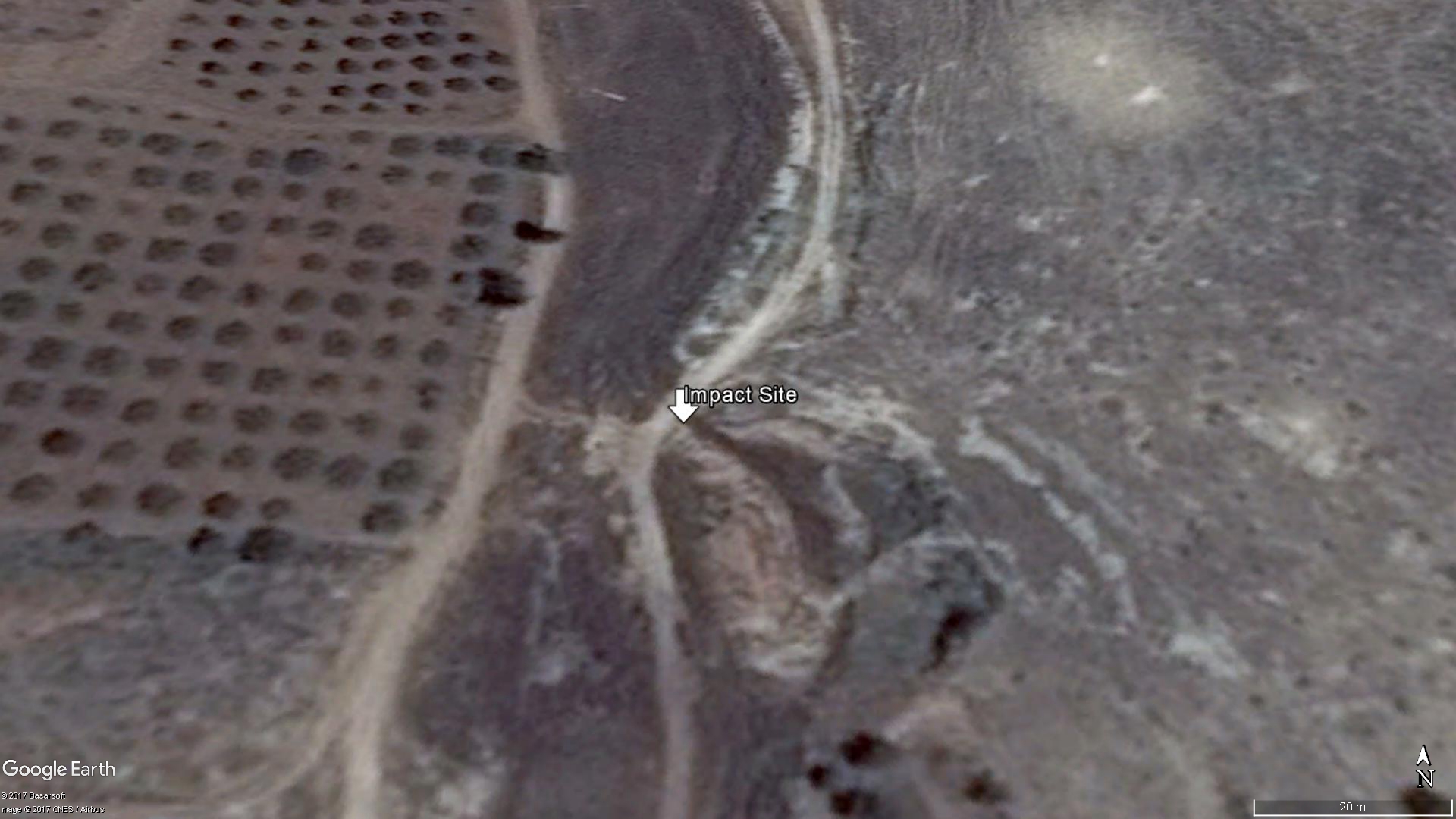
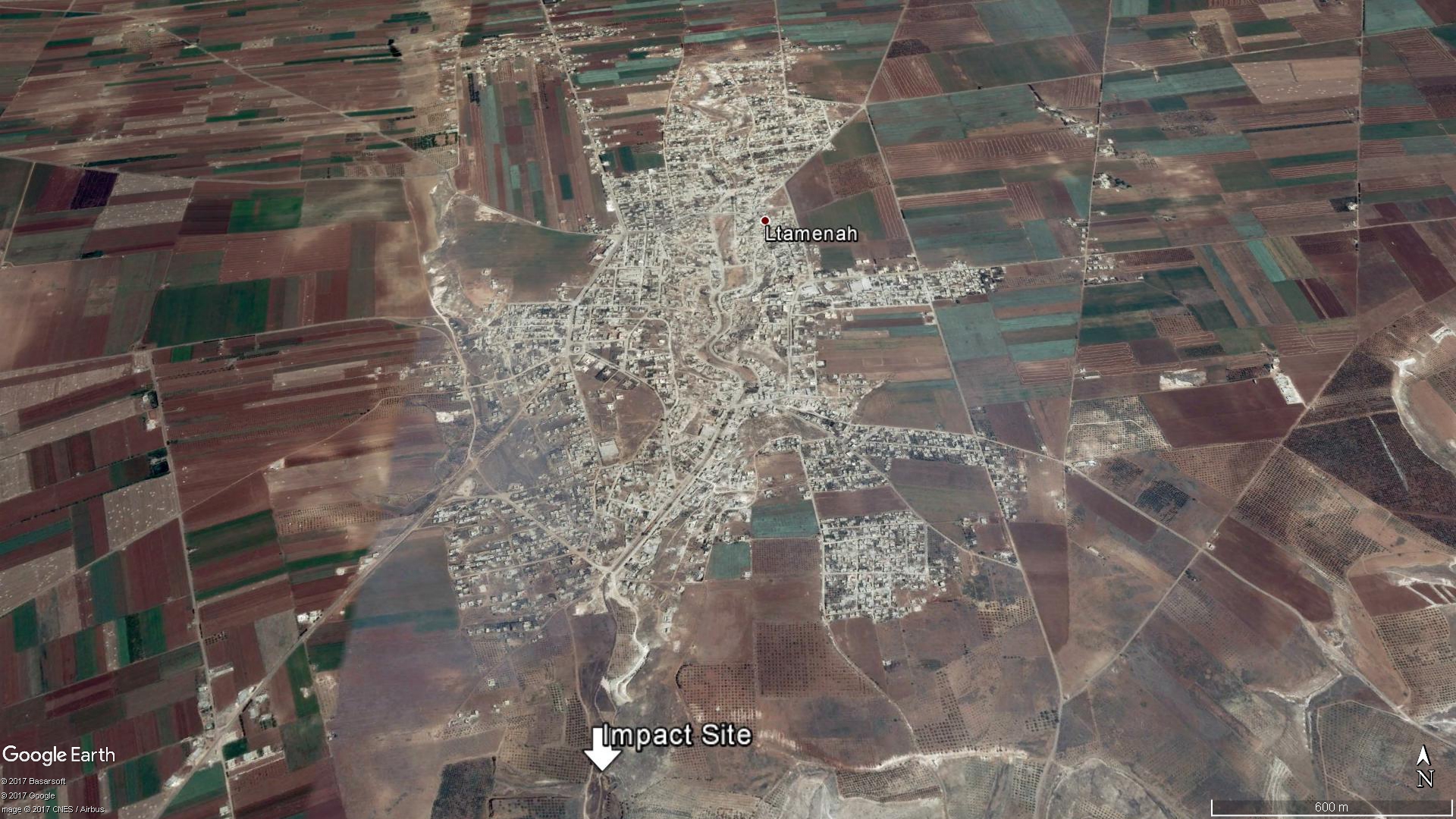
One video filmed by local cameraman Mahmod Hamway was posted at 7:17am local time on March 30 and claims to show the moment of the attack. We managed to geolocate the video, but for the safety of the cameraman, we will not publish details of the location of the camera. Based on the location of the camera, the direction of the smoke cloud that appears is in line with the geolocated impact site. Bellingcat also contacted Forensic Architecture who reviewed the images, and who established that based on the imagery the smoke visible was approximately 3.3 kilometers away from the camera, which would be close to known impact site. Therefore, there is a strong possibility this is the moment of attack, but it is unclear if this is the Sarin bomb, or another munitions used in the same attack, as per the witness statements:
Mahmod Hamway stated the attack was carried out by an SU-22, consistent with claims made by the Shaam News Network, and that it came from Shayrat Airbase, although he presented no evidence to support this claim. He also stated that other aircraft attacked the town on the same day, and the SU-22 carried out a second airstrike in the village of Zour al-Mahrouka (three kilometers south of Al-Lataminah) with Sarin. He said that the name of the village is not very well known, so reports might have said that this strike instead hit Al-Lataminah.
We also spoke to a member of the Syrian Civil Defence chemical team who attended the scene. He stated that information that an SU-22 was responsible for the attack was passed on by aircraft observers, and that two bombs containing Sarin had been dropped on that day. He also stated that samples from the attack were sent to the OPCW, who confirmed Sarin was used in the attack.
The Bellingcat Investigation Team has found no additional information about this second alleged Sarin attack on Zour al-Mahrouka.
The impact site is around 300 meters away from the nearest buildings, but fewer than 200 meters to the north is a particularly interesting location. At the beginning of the Russian Syria air campaign in September 2015, this location, an apparent rebel underground complex, was featured in three different published Russian MoD videos showing airstrikes on the location. In each of the three videos, the Russian MoD falsely claimed that ISIS was being bombed when ISIS was not in the area at the time, and in one case, wrongly claimed the location was in Raqqa:
While, as some witnesses suggest, the farmers in the field may have been the target of the attack, the presence of this rebel-controlled underground facility would be a more obvious target for a chemical weapon such as Sarin. The member of the Syrian Civil Defence team who attended the scene told Bellingcat that the area had been attacked previously with chlorine gas. If the Zour al-Mahrouka Sarin attack did occur after the Al-Lataminah attack, then the possible target at that location may also be rebel-held underground facilities. While we know about the presence of those underground facilities, there are no further details about the alleged second Sarin attack in Zour al-Mahrouka. At this point, without these details, we can only speculate on the intended target for the second attack, if it took place at all.
In video footage of the attack site examined by Bellingcat, the precise impact site appears to be the end of a ridge, just east of a north-south road. In various videos filmed in the hours and days after the attack, two Syrian Civil Defence members dressed in protective equipment can be seen gathering samples from the crater:
It is notable that the Syrian Civil Defence members filmed in the March 30th videos are using the same case and protective equipment seen in a video filmed after the April 4, 2017 Khan Sheikhoun Sarin attack:
Footage from March also shows how the area around the impact site is stained with a dark substance, and plants in the surrounding area have begun to wither:
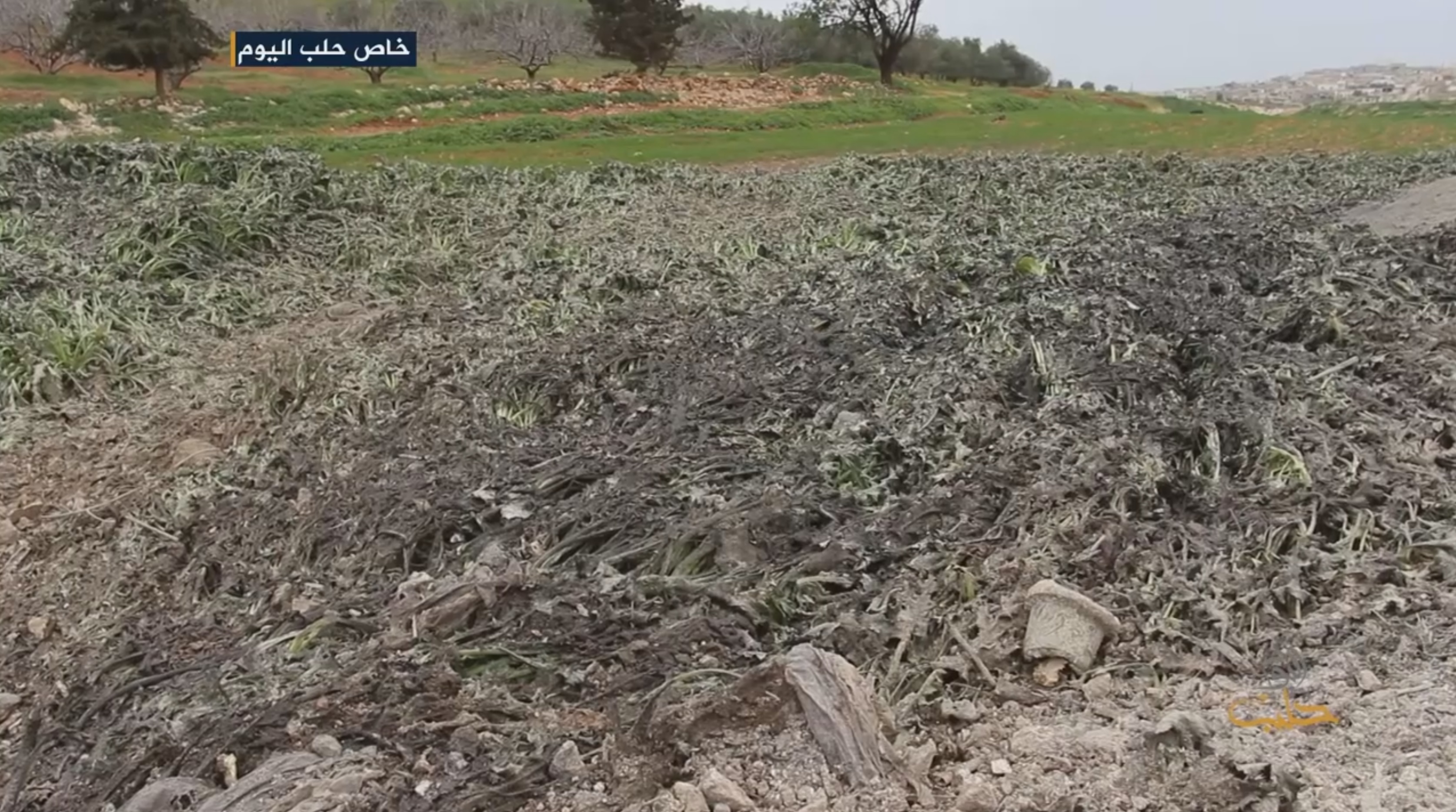
Dark staining of the ground around the crater was also apparent at the site of the April 4th Khan Sheikhoun Sarin attack. While pure Sarin is colourless, the Sarin that has previously been used by the Syrian government is not pure, with the French National Evaluation released after the Khan Sheikhoun attack describing the contents of a Sarin filled munition recovered from another Sarin attack in Saraqib in 2013 as “a solid and liquid mix of approximately 100ml of sarin at an estimated purity of 60%. Hexamine, DF and a secondary product, DIMP, were also identified.”
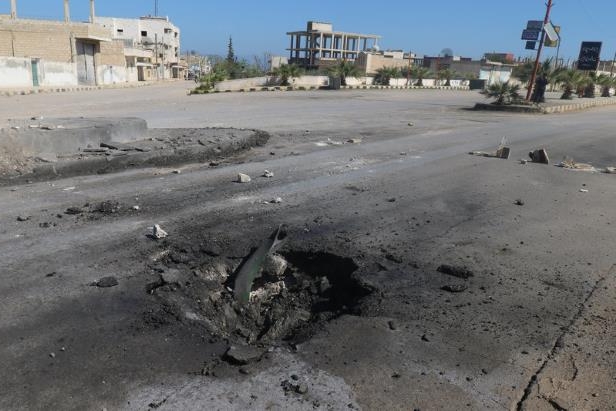
In addition to what appears to be the impact site of the Sarin bomb, the videos also feature a yellow cylinder with markings for chlorine gas in what appears to be the same general location as the apparent Sarin impact crater. When asked about this, the member of the Syrian Civil Defence team who responded to the attack stated the area had been previously attacked with chlorine gas.
Satellite imagery of the area taken between February 21 and May 30, 2017 shows signs of craters and damage across the area, suggesting that this area was actively targeted by Syrian and Russian forces during that period:
The Munition
An object of great interest is the munition used in the attack. Videos filmed shortly after the attack show various debris and a cracked-open yellow cylinder, which appears to be unrelated to the Sarin attack munition. As the area to the north has been targeted by multiple attacks for over two years, it is difficult to be sure if every item filmed and photographed in the area is related to the Sarin attack, but some items stand out. In footage from the SMART News Agency published on March 31, there are a number of items of interest, including this still-unidentified object. As of the publication of this article, we have not yet been able to match this object with any known munition, and it is impossible to conclude if it relates to a munition, or is some other item:
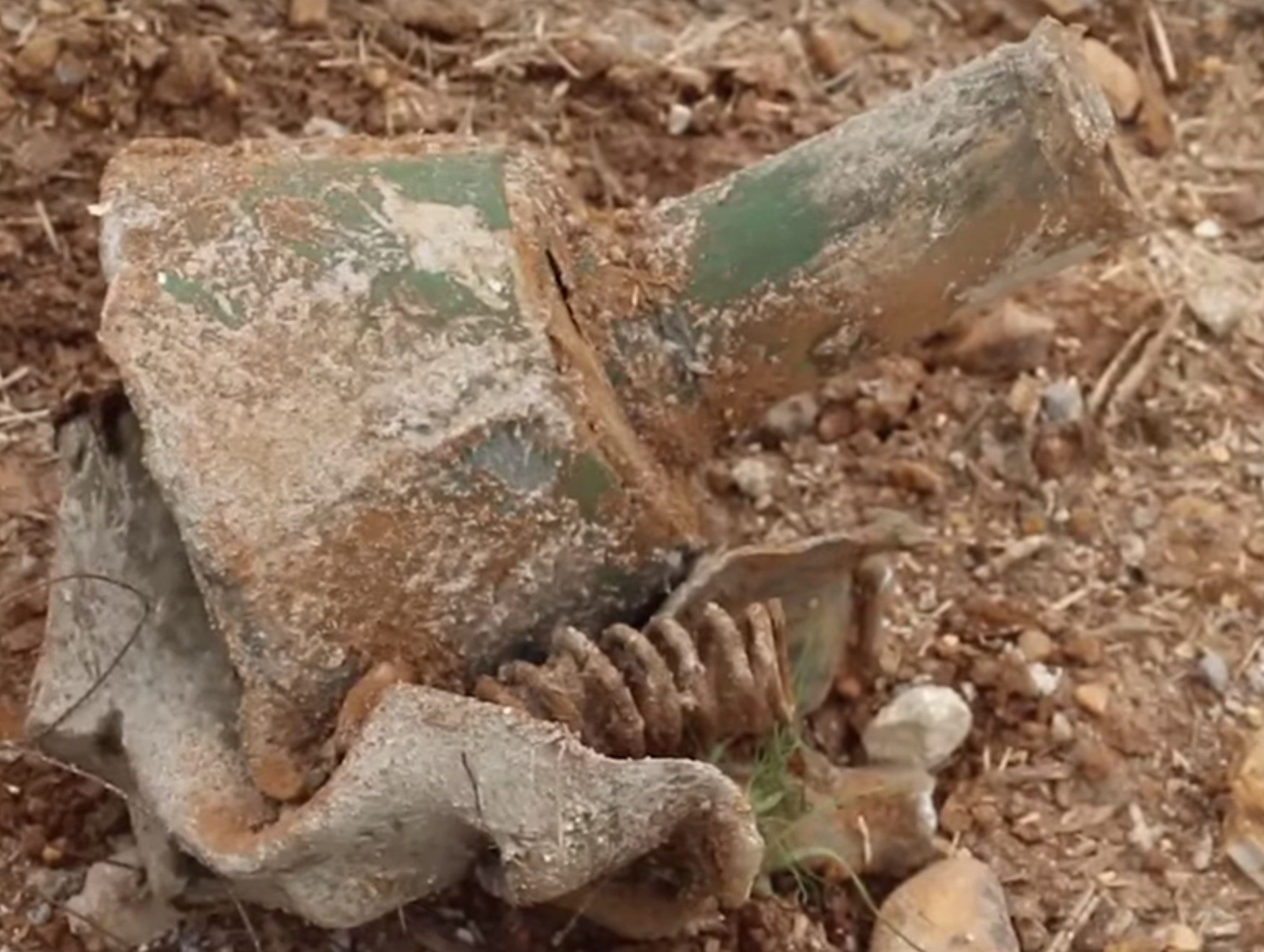
Also featured in the same video is a large, damaged sheet of metal with folded edges, along with a smaller piece of metal with a circular structure:
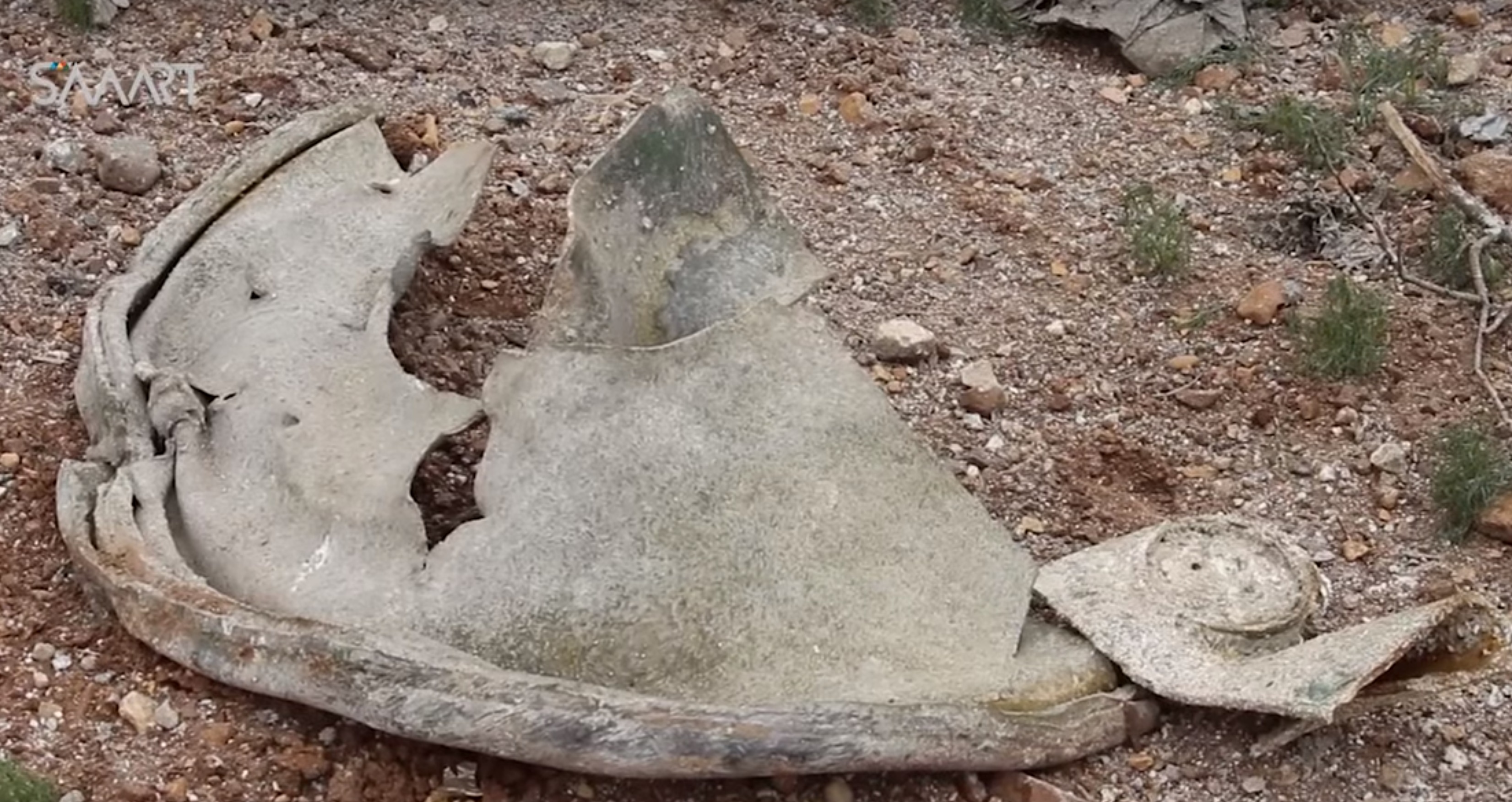
The circular structure has features similar to those of what is believed to be a filling cap recovered from the crater of the April 4th Khan Sheikhoun chemical attack. Of particular interest is a small hole visible in the object shown above, as this same feature is visible in the Khan Sheikhoun cap. When both caps are overlaid with each other it is apparently the position of the hole is the same distance from the out edge in both examples:
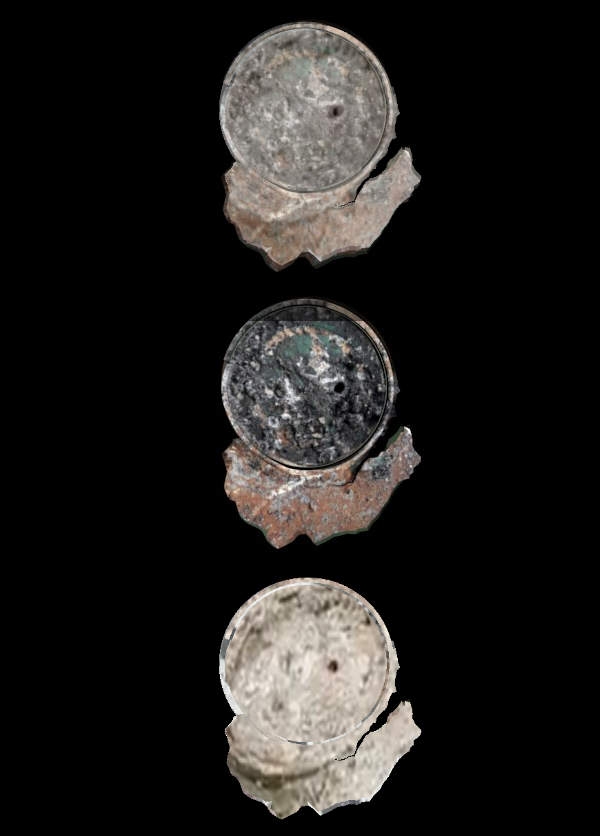
This similarity is an indication these are the same design of cap, and therefore the same type of munition may have been used in both the March 30th attack and the April 4th attack. If the items from Khan Sheikhoun and Al-Lataminah have been recovered and sent to the OPCW, it will be possible for the OPCW to examine the materials used in the construction of these items, and see if the type of metal used matches, which would further confirm their link.
Conclusion
Open source evidence and other evidence gathered about the attack is consistent with the OPCW statement that Sarin had been used in an attack on March 30. Documentation of the second site in Zour al-Mahrouka was not discovered in this investigation, and as only details about the location of the attack are available from two witnesses it is impossible to draw any conclusions about this second alleged attack on March 30th. One impact site has been geolocated to a site south of Al-Lataminah, near an apparent rebel underground base. The debris at this site matches debris found at the April 4th Khan Sheikhoun impact site, indicating the possibility that the same type of munition was used in at least one of the March 30th attacks.
Witness statements indicate that the attack was performed by an SU-22 from Shayrat Airbase, which matches claims from various parties about the method and origin of attack in the April 4, 2017 attack in Khan Sheikhoun. However, at this moment there is no direct evidence available to the Bellingcat Investigation Team to support this specific claims. The UN’s Independent International Commission of Inquiry on the Syrian Arab Republic has stated that the perpetrator was the Syrian Government, and while some witnesses have said the Russian Air Force was responsible, there is no direct evidence to support that claim.
